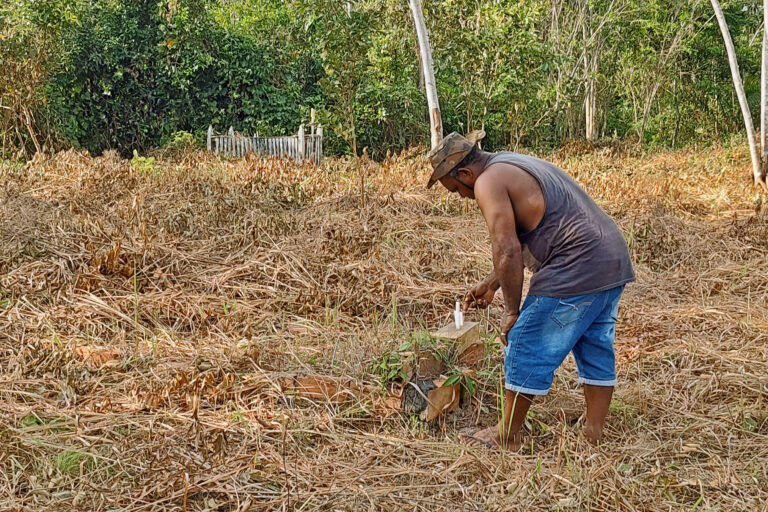Measures throughout 2023 to curb the illegal gold trade in Brazil led to a 20% drop in the country’s exports of the precious metal.
“Don’t go to Zabaleta because they’re going to kill you.” “Why are they going to kill me if I haven’t done anything?” “They’re going to kill you, please don’t go…
JAKARTA — The tropics continue to lose primary forest at an alarming rate, with an area of tree cover half the size of Panama disappearing in 2023, new data from…
The Brazilian Congress is analyzing a bill that would leave all the country's non-forestry vegetation unprotected, affecting an area twice the size of the United Kingdom.
One of the final stages in demarcating the Amazonian territory of the isolated Kawahiva tribe is set to take place this year, Brazil’s Ministry of Indigenous Peoples has announced. It’s…
Both Lula and the Supreme Court have previously called the measures in the bill unconstitutional and against public interests, and Indigenous organizations announced they will challenge the law.
The Sawré Muybu Indigenous Territory is in the final stages of getting state protection, but previous right-wing administrations delayed demarcation.
Indigenous people and advocates are fighting for the Tanaru Indigenous land to remain an Indigenous territory, but ranchers want to take possession of the plot to turn it into pastures and soy fields.
Indigenous forest guardian Paulo Paulino Guajajara was killed in November 2019 in the Brazilian Amazon. Mongabay’s Karla Mendes, who interviewed Paulo nine months before his death, returned to the Arariboia Indigenous Territory in August 2023 to talk with his family and the other guardian who survived the attack, Laércio Guajajara, and shine a light on a case that still hasn’t gone to trial after four years.
Human rights activists praise the move as Indigenous communities within these lands continue to struggle against soaring levels of deforestation and decades-old conflicts with outsiders.
In just 72 hours this month, five Indigenous people were wounded by gunfire in violent attacks in a part of the Brazilian Amazon dubbed the “palm oil war” region, sparking outrage and claims for justice.
The suspect, Bruno Heller, destroyed 6,500 hectares (16,100 acres) of Amazon Rainforest for cattle ranching — an area larger than the island of Manhattan — according to authorities.
Between Aug. 4 and Aug. 7, security guards for a palm oil company allegedly shot and wounded five Tembé Indigenous people, in the latest flareup linked to a long-running land dispute. The incidents occurred in a part of the Amazonian state of Pará that’s been dubbed the “palm oil war” region, where Mongabay has over the past year documented the escalating tensions.
In the Ecuadorian Amazon, a region marked by half a century of extractive industries, mainly oil, deforestation is a constant. In recent years, a new threat to the conservation of…
JAKARTA — The tropics lost 10% more primary rainforest in 2022 than in 2021, as forest loss in deforestation hotspots like Brazil and the Democratic Republic of Congo (DRC) continued…
The alerts of illegal mining in the Yanomami Indigenous Land have zeroed for the first time since 2020, according to satellite monitoring by the Brazilian Federal Police.
With Lula taking office early this year, the fund was resumed and should get new donations from the U.K. and the United States.
Indigenous territories with secure land rights not only reduce deforestation inside their lands in the Brazilian Amazon, but also lead to higher secondary forest growth on previously deforested areas, says…
This story was supported by the Pulitzer Center’s Rainforest Investigations Network where Karla Mendes is a fellow. A prominent Indigenous leader was shot in the head on May 14…
In an interview with Mongabay, Alessandra discusses what the prize means to her, the policy changes in Brazil, and the current crisis in the Munduruku territory.
Engineers and realtors from southern Pará take advantage of their knowledge to abet land grabbers.
When asked if he had a message for the world, Júnior Hekurari Yanomami was emphatic: “Don’t buy Brazilian gold.” Júnior, 36, from the Surucucu community on Brazil’s largest and most…
After four years of environmental destruction, Brazil has reached a crossroads that will determine the fate of its biomes and its role in the global climate crisis. In its first…
PORTO VELHO, Brazil — Cruising north in a speedboat along the Madeira River, the signs of Brazil’s illegal gold mining boom are everywhere: mounds of sand extracted from the riverbed…
A Mongabay investigation into land-grabbing in the Brazilian Amazon has led to the suspension of the sustainability certificate of the country's second top palm oil exporter, as shown in email correspondence…
A new legislative proposal, criticized by opponents as a step backwards in recognizing the rights and protections of uncontacted and recently contacted Indigenous people, is currently under debate in Peru’s…
In 2015, researchers in Brazil started a project to address a tricky challenge: Reducing exposure to mercury contamination in the region of the Tapajós River, a major tributary of the…
SÃO PAULO — Since the new Brazilian government under President Luiz Inácio Lula da Silva took office on Jan. 1, its ministries have been working together to overcome a humanitarian…
In January, a wave of outrage swept Brazil after photos and footage of sick and starving Yanomami were made public. The newly sworn-in Brazilian president, Luiz Inácio Lula da Silva,…
XINGU RIVER, Brazil — Deep in the Brazilian Amazon, our motorboat slides past an emerald canopy of rainforest, cascading down to the banks of the Xingu River. Beyond, in the…





































